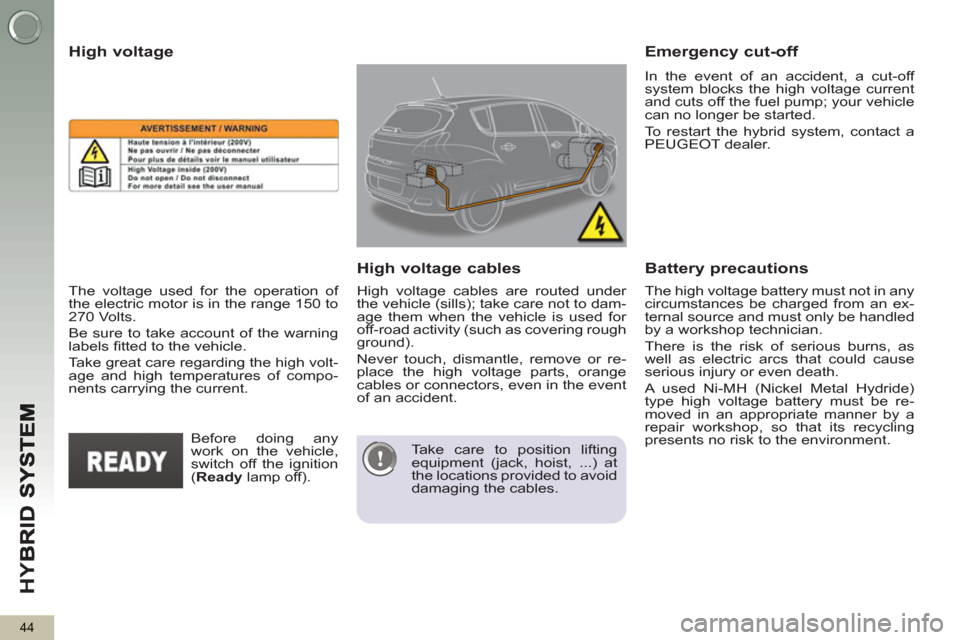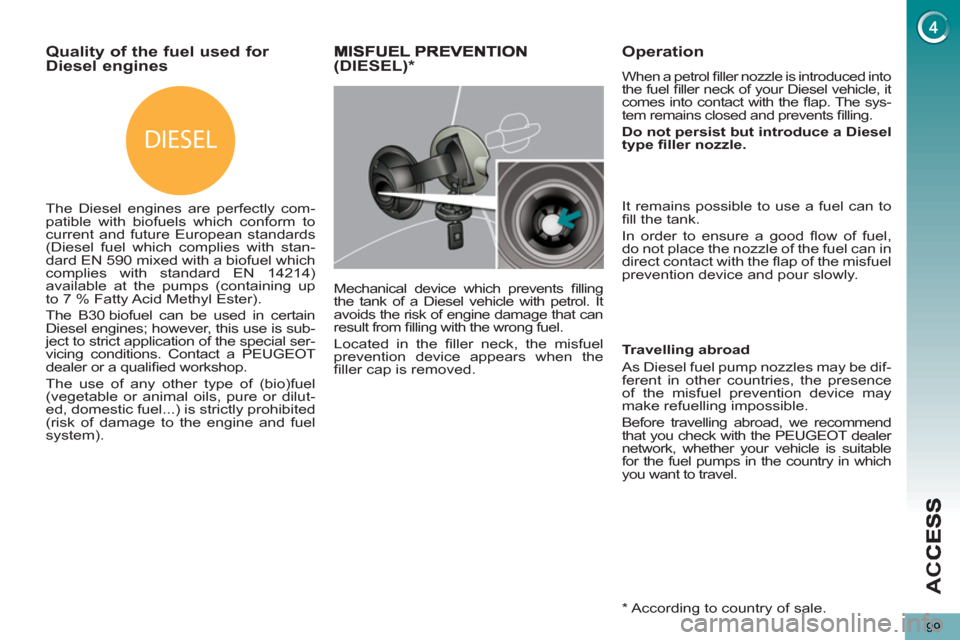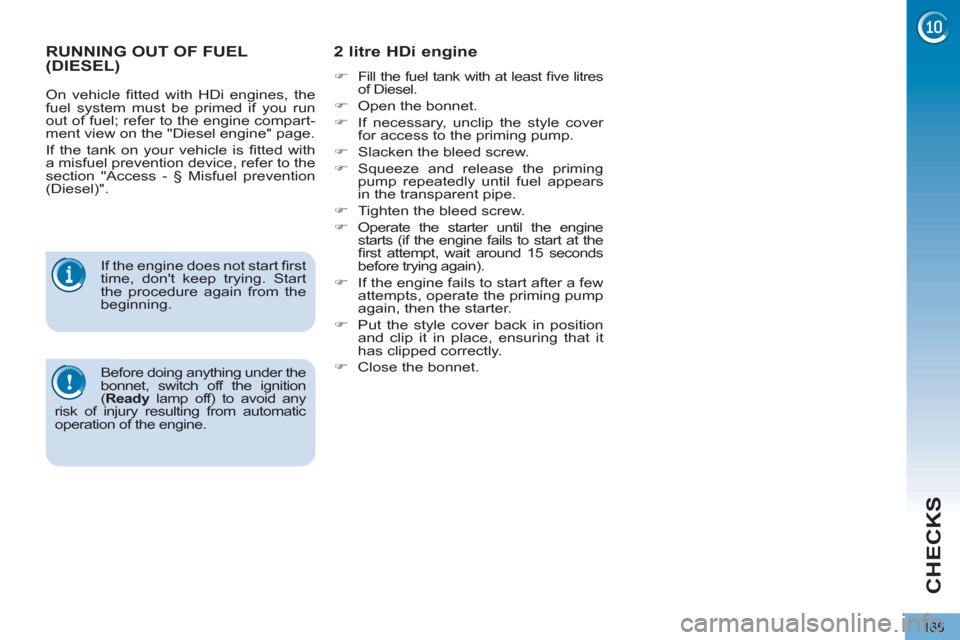Page 46 of 284

HY
B
44
The high voltage battery must not in any
circumstances be charged from an ex-
ternal source and must only be handled
by a workshop technician.
There is the risk of serious burns, as
well as electric arcs that could cause
serious injury or even death.
A used Ni-MH (Nickel Metal Hydride)
type high voltage battery must be re-
moved in an appropriate manner by a
repair workshop, so that its recycling
presents no risk to the environment.
High voltage
The voltage used for the operation of
the electric motor is in the range 150 to
270 Volts.
Be sure to take account of the warning
labels fi tted to the vehicle.
Take great care regarding the high volt-
age and high temperatures of compo-
nents carrying the current.
Emergency cut-off
High voltage cables are routed under
the vehicle (sills); take care not to dam-
age them when the vehicle is used for
off-road activity (such as covering rough
ground).
Never touch, dismantle, remove or re-
place the high voltage parts, orange
cables or connectors, even in the event
of an accident.
Before doing any
work on the vehicle,
switch off the ignition
( Ready
lamp off).
Battery precautions High voltage cables
Take care to position lifting
equipment (jack, hoist, ...) at
the locations provided to avoid
damaging the cables.
In the event of an accident, a cut-off
system blocks the high voltage current
and cuts off the fuel pump; your vehicle
can no longer be started.
To restart the hybrid system, contact a
PEUGEOT dealer.
Page 101 of 284

DIESEL
AC
C
99
Quality of the fuel used for Diesel engines
The Diesel engines are perfectly com-
patible with biofuels which conform to
current and future European standards
(Diesel fuel which complies with stan-
dard EN 590 mixed with a biofuel which
complies with standard EN 14214)
available at the pumps (containing up
to 7 % Fatty Acid Methyl Ester).
The B30 biofuel can be used in certain
Diesel engines; however, this use is sub-
ject to strict application of the special ser-
vicing conditions. Contact a PEUGEOT
dealer or a qualifi ed workshop.
The use of any other type of (bio)fuel
(vegetable or animal oils, pure or dilut-
ed, domestic fuel...) is strictly prohibited
(risk of damage to the engine and fuel
system).
(DIESEL)
*
Mechanical device which prevents fi lling
the tank of a Diesel vehicle with petrol. It
avoids the risk of engine damage that can
result from fi lling with the wrong fuel.
Located in the fi ller neck, the misfuel
prevention device appears when the
fi ller cap is removed.
Operation
When a petrol fi ller nozzle is introduced into
the fuel fi ller neck of your Diesel vehicle, it
comes into contact with the fl ap. The sys-
tem remains closed and prevents fi lling.
Do not persist but introduce a Diesel
type fi ller nozzle.
It remains possible to use a fuel can to
fi ll the tank.
In order to ensure a good fl ow of fuel,
do not place the nozzle of the fuel can in
direct contact with the fl ap of the misfuel
prevention device and pour slowly.
*
According to country of sale.
Travelling abroad
As Diesel fuel pump nozzles may be dif-
ferent in other countries, the presence
of the misfuel prevention device may
make refuelling impossible.
Before travelling abroad, we recommend
that you check with the PEUGEOT dealer
network, whether your vehicle is suitable
for the fuel pumps in the country in which
you want to travel.
Page 167 of 284

CHECKS
165
RUNNING OUT OF FUEL(DIESEL)
2 litre HDi engine
�)
Fill the fuel tank with at least fi ve litres
of Diesel.
�)
Open the bonnet.
�)
If necessary, unclip the style cover
for access to the priming pump.
�)
Slacken the bleed screw.
�)
Squeeze and release the priming
pump repeatedly until fuel appears
in the transparent pipe.
�)
Tighten the bleed screw.
�)
Operate the starter until the engine
starts (if the engine fails to start at the
fi rst attempt, wait around 15 seconds
before trying again).
�)
If the engine fails to start after a few
attempts, operate the priming pump
again, then the starter.
�)
Put the style cover back in position
and clip it in place, ensuring that it
has clipped correctly.
�)
Close the bonnet.
Before doing anything under the
bonnet, switch off the ignition
( Ready
lamp off) to avoid any
risk of injury resulting from automatic
operation of the engine.
On vehicle fi tted with HDi engines, the
fuel system must be primed if you run
out of fuel; refer to the engine compart-
ment view on the "Diesel engine" page.
If the tank on your vehicle is fi tted with
a misfuel prevention device, refer to the
section "Access - § Misfuel prevention
(Diesel)".
If the engine does not start fi rst
time, don't keep trying. Start
the procedure again from the
beginning.
Page 168 of 284
CHECKS
166
DIESEL ENGINE
The various caps and covers allow access for checking the levels of the various fl uids, for replacing certain components and
for priming the fuel system.
1.
Power steering reservoir.
2.
Screenwash and headlamp wash
reservoir.
3.
Coolant reservoir.
4.
Brake fl uid reservoir.
5.
Battery / Fuses.
6.
Fusebox.
7.
Air fi lter.
8.
Engine oil dipstick.
9.
Engine oil fi ller cap.
10.
Priming pump.
11 .
Bleed screw.